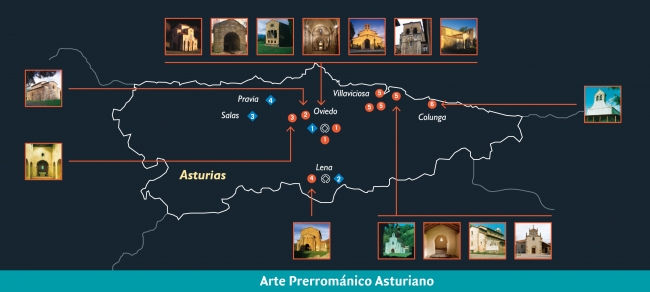Monuments
Asturias conserves the most comprehensive and consistent collection of late mediaeval architecture in Western Europe. Dated from the ninth and the early tenth centuries, these monuments are unparalleled in their quality and magnificent state of conservation. The value of the architecture adds to the extraordinary craftsmanship, and together produce a force comparable to that of other European "revival periods"; similar to the levels achieved by the Carolingian or Byzantine courts.
This art constitutes the most meaningful testimony of the historical roots and cultural traditions of the origins of the Kingdom of Asturias. This legacy includes twelve temples and three civil constructions.
Among the temples are Santuyano (791-842), San Miguel de Lliño (844-850), San Pedru Nora (9th c), Santa María de Bendones (9th c), Santa Cristina de Lena (towards 848), Santo Adriano de Tuñón (consecrated in 891), San Salvador de Valdediós (consecrated in 893), San Salvador de Priesca (consecrated in 921), Santiago de Gobiendes (second half of the 9th c), Santa María de Arbazal (centuries 8th to 10th), San Andrés de Bedriñana (9th c), and the Holy Chamber of San Salvador de Oviedo/Uviéu (towards 884).
Among the civil constructions are Santa María de Naranco (altar dedicated in 848), the so-called Old Tower of San Salvador de Oviedo (probably coetaneous to the Holy Chamber) and the Foncalada fountain in Oviedo/Uviéu (first half of the 9th c). Other Asturian temples preserve parts attributable to the High Middles Ages period, such as Santianes de Pravia (774-783) or the head wall of San Tirso de Oviedo (791-842).
Six Asturian pre-Romanesque monuments are UNESCO World Heritage Sites since 1985, for being a relevant sample of the culture of the Christian kingdom of Asturias, developed at the time of greatest splendour of the Emirate of Córdoba, and as a result of the notable influence it exercised on later European architecture.











